Schedule Maintenance for Configured and Active Hosts#
You can schedule the maintenance of your configured and active hosts using the Schedule Maintenance feature. This feature helps you define time-based events, such as administrative downtime (for example, to move a node), maintenance windows, software updates, or other events that may happen once or need to be repeated on a schedule.
Maintaining a proper maintenance schedule helps prevent unexpected downtime and allows timely updates of hardware and software.
Some examples of administrative downtime are:
Shipping or moving of an edge node
Planned Internet downtime at the edge node site
Planned electrical power downtime at the edge node site
Physical edge node maintenance: refer to the edge node manufacturer documentation to do physical maintenance (for example, power supply unit failure)
Note
Some physical edge node maintenance may require node re-provisioning. For example, a hard-disk swap.
Schedule a Maintenance for a Single Edge Node#
To schedule maintenance for a single Edge Node, do the following:
On the Configured Host or Active Host page, select the host that you want to schedule maintenance for.
Click the three-dot (…) icon in the Actions column for the desired host and select Schedule Maintenance. The Maintenance Details page appears:
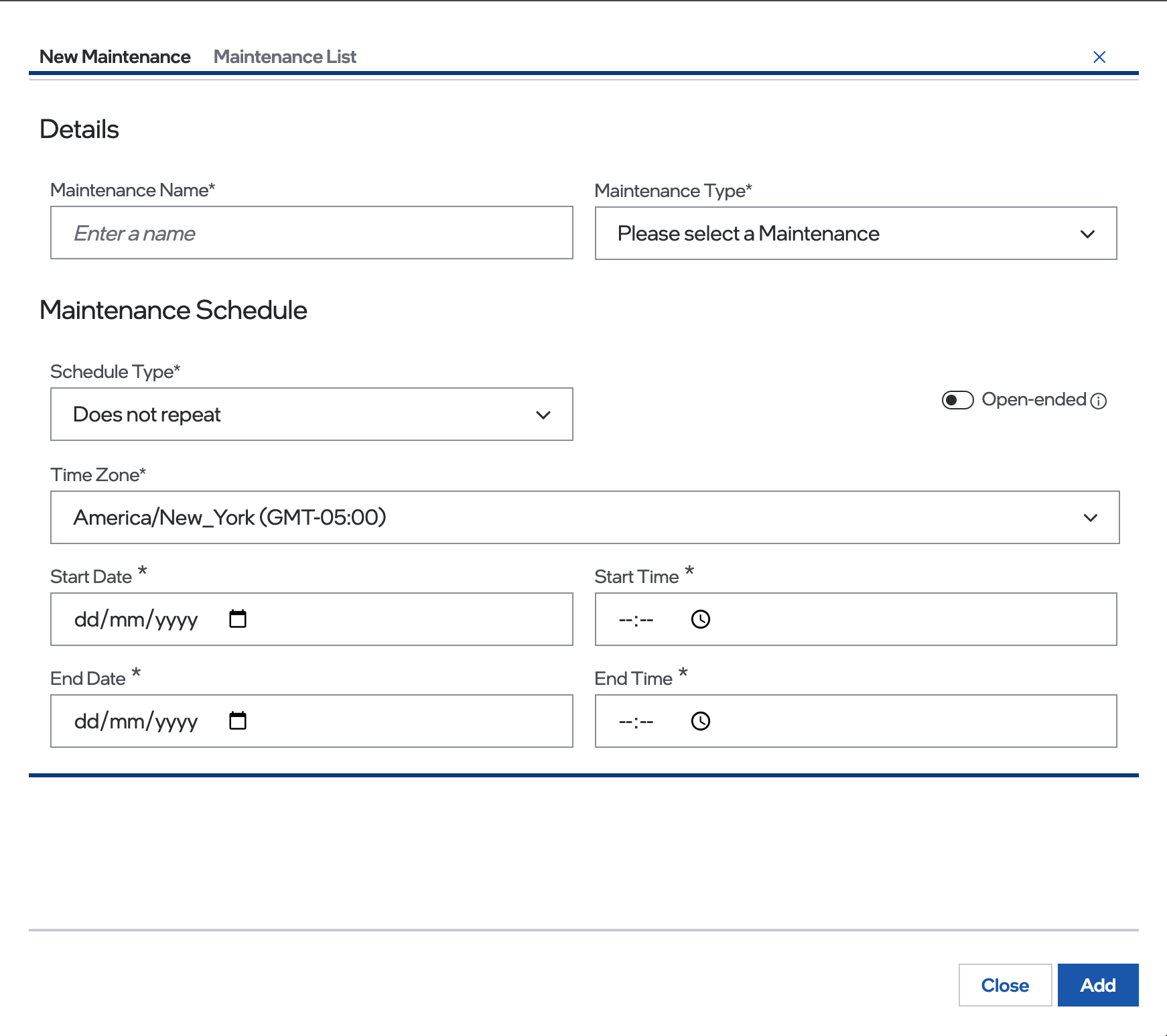
Enter a name in the Maintenance Name field. The name is useful to identify the scheduled maintenance when more are available.
Select the maintenance type in the Maintenance Type field. The available maintenance types are:
Maintenance: To schedule any administrative downtime or edge node maintenance.
- OS Update: To schedule edge node software updates (i.e. updates of already installed packages or to install new packages):
Refer to Update an Edge Node’s Immutable OS Software for more information regarding the update of edge node’s immutable Edge Microvisor Toolkit operating system software.
Refer to Install a New Debian* Package on Mutable OS to install new packages and update an edge node with mutable Ubuntu* OS.
Select the schedule type from the Schedule Type drop-down box. You have the option to select one of the following schedule type:
Does not repeat: The maintenance is scheduled for one time only on the provided start and end date and time
Repeat by day of week: Repeat the schedule on a specified day(s) of the week (for example, each Tuesday and Thursday)
Repeat by day of month: Repeat the schedule on a specified day(s) of the month (for example, each first day of the month)
Select the time zone from the Time Zone drop-down box.
If you have selected “Does not repeat” as the schedule type:
Update the Start Date and Start Time according to your needs.
If the schedule is open-ended (unknown end date and time), toggle the Open-ended control.
Note
This is supported only if the schedule does not repeat. If the schedule is open-ended, you need to remove the edge node manually from maintenance. Refer to Delete Scheduled Maintenance or End Maintenance.
If the schedule has a known end date and time, update the End Date and End Time according to your needs.
If you have selected “Repeat by day of week” or “Repeat by day of month” as the schedule type:
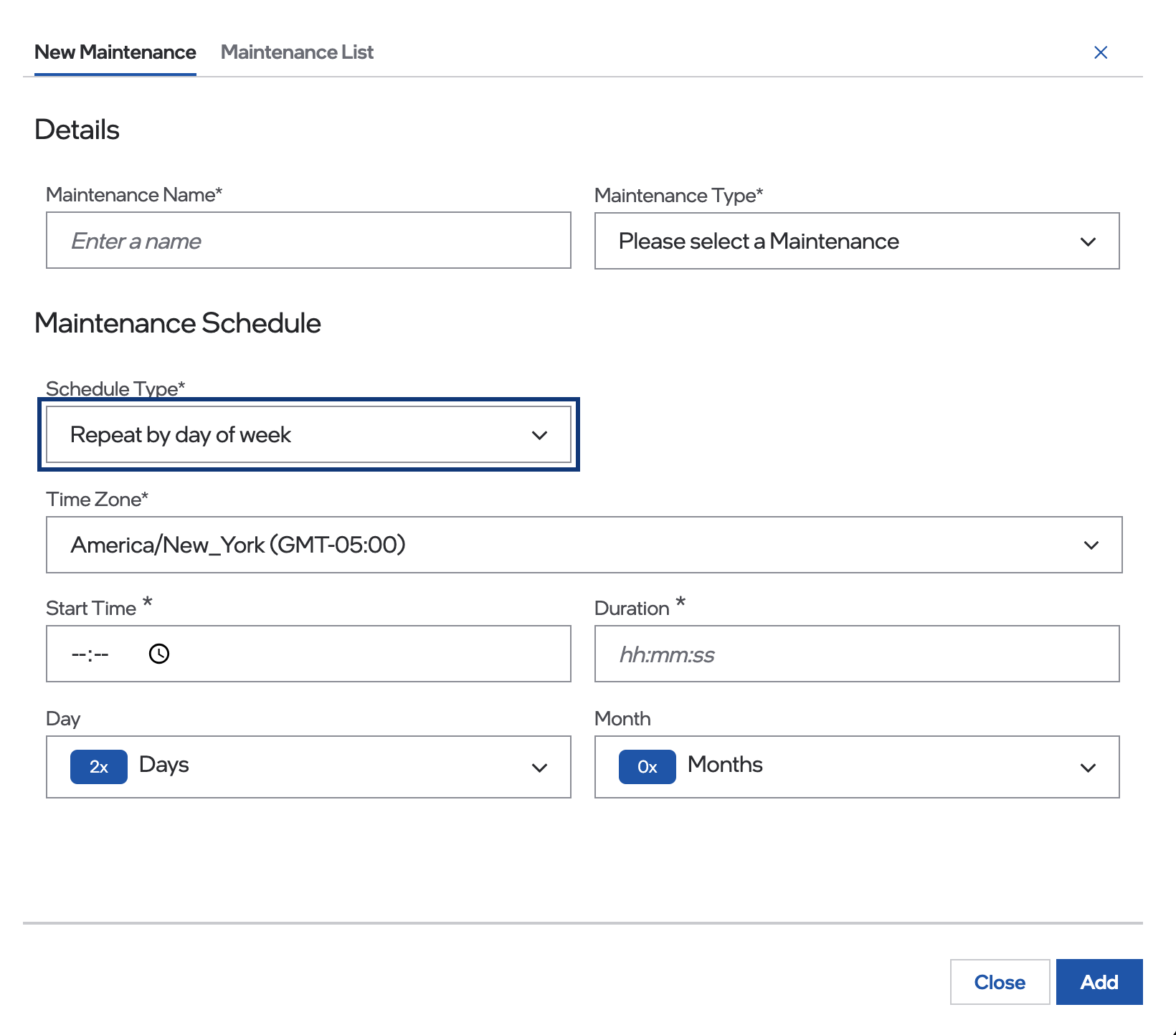
Update the Start Time and Duration according to your needs.
Update the Day (could be day of the week or day of the month) and Months according to your needs.
Click Add
Schedule a Maintenance for all Edge Nodes in the Same Region#
Maintenance windows can be scheduled at a Region level as well. A Maintenance scheduled on a Region will be automatically applied to all elements in that region hierarchy: subregions, sites and hosts.
To schedule a maintenance for a Region do the following:
In the Locations tab pick the region and click on the three dots for it’s contextual menu.

In the contextual menu tab click on Schedule Maintenance, The Maintenance Details page for the region appears:
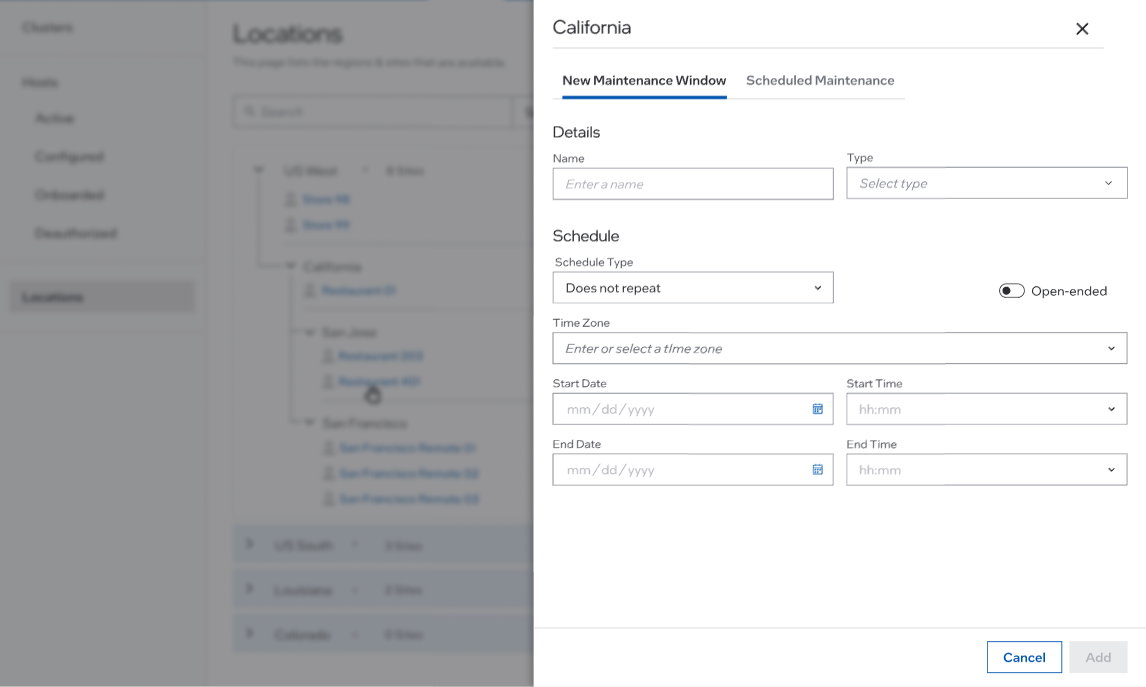
Insert the details for the maintenance. The details are identical to the ones from the section above for a single host.
Click Add. A green pop-up will notify of the creation of the Maintenance
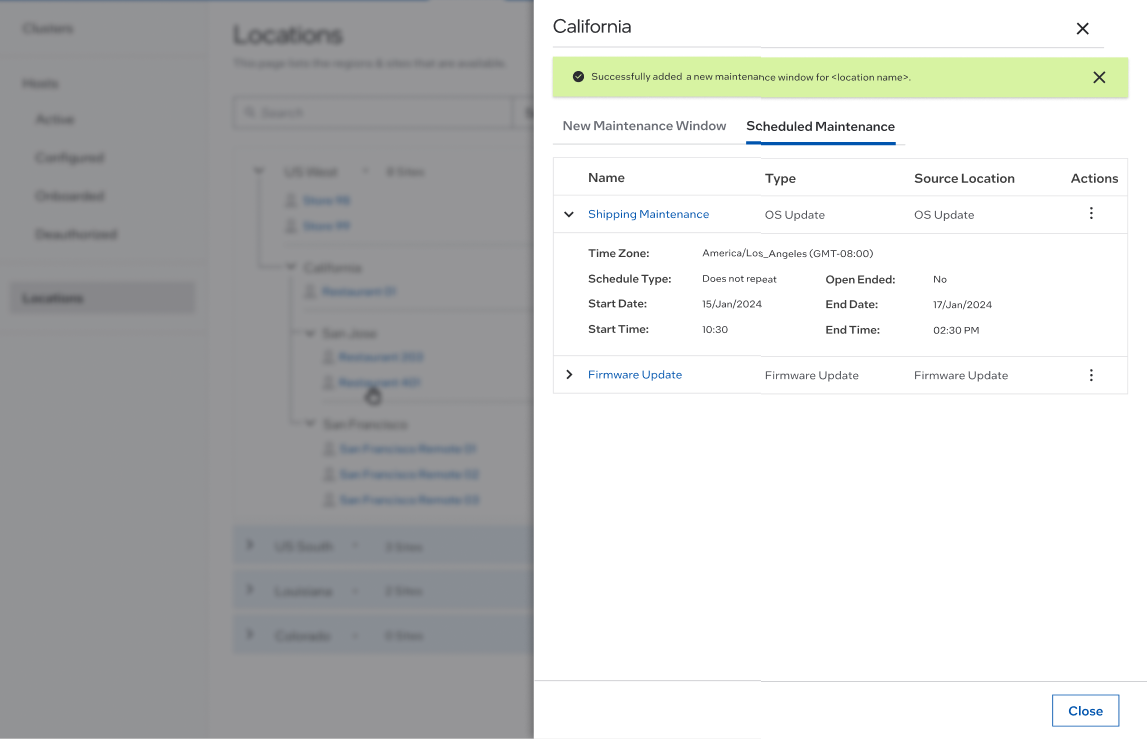
Delete Scheduled Maintenance or End Maintenance#
1. On the Maintenance Details page of either a Host or a Region, click Maintenance List. The list of maintenance schedules for the given element appears. The list includes all types of maintenance schedules (not repeated, open-ended, repeated weekly, repeated monthly):

Click on the three-dot (…) icon in the Actions column and select Delete.
Deleting a non repeated schedule that has not arrived at the end date and time means that the maintenance for that edge node(s) ends.
Deleting an open-ended schedule means that the maintenance for that edge node or all the edge node(s) ends.
Deleting a repeated schedule means that all future schedule maintenance for the given edge node(s) are cancelled.
A confirmation window appears. Click Delete to confirm the deletion.
Repeat the operation to delete other maintenance schedules.
Verify the Status of a Node’s Latest Update#
Every Node provides Edge Orchestrator with its status related to software updates. There are eight possible update status messages that the Edge Orchestrator registers for the end user:
No new updates available - indicates that no software update is currently in progress.
Updating - indicates that a software update is currently in progress.
- Update complete, x package(s) updated/installed - indicates a successful software update in case of mutable OS updates.
This message holds the number of packages modified during the update.
Update complete - indicates a successful software update in case of immutable OS updates.
Update failed - indicates that the latest software update ended with failure.
Downloading artifacts - indicates that artifacts for immutable OS update are being downloaded.
Download complete - indicates that artifacts for immutable OS update were downloaded successfully.
Unknown - indicates an unsupported case.
You can view Update Status from one of the Hosts detailed view pages.
Navigate to the Active Hosts page.
Click the hostname to view the host details, or click the three-dot icon in the Actions column, select View Details and observe the “Update Status”:
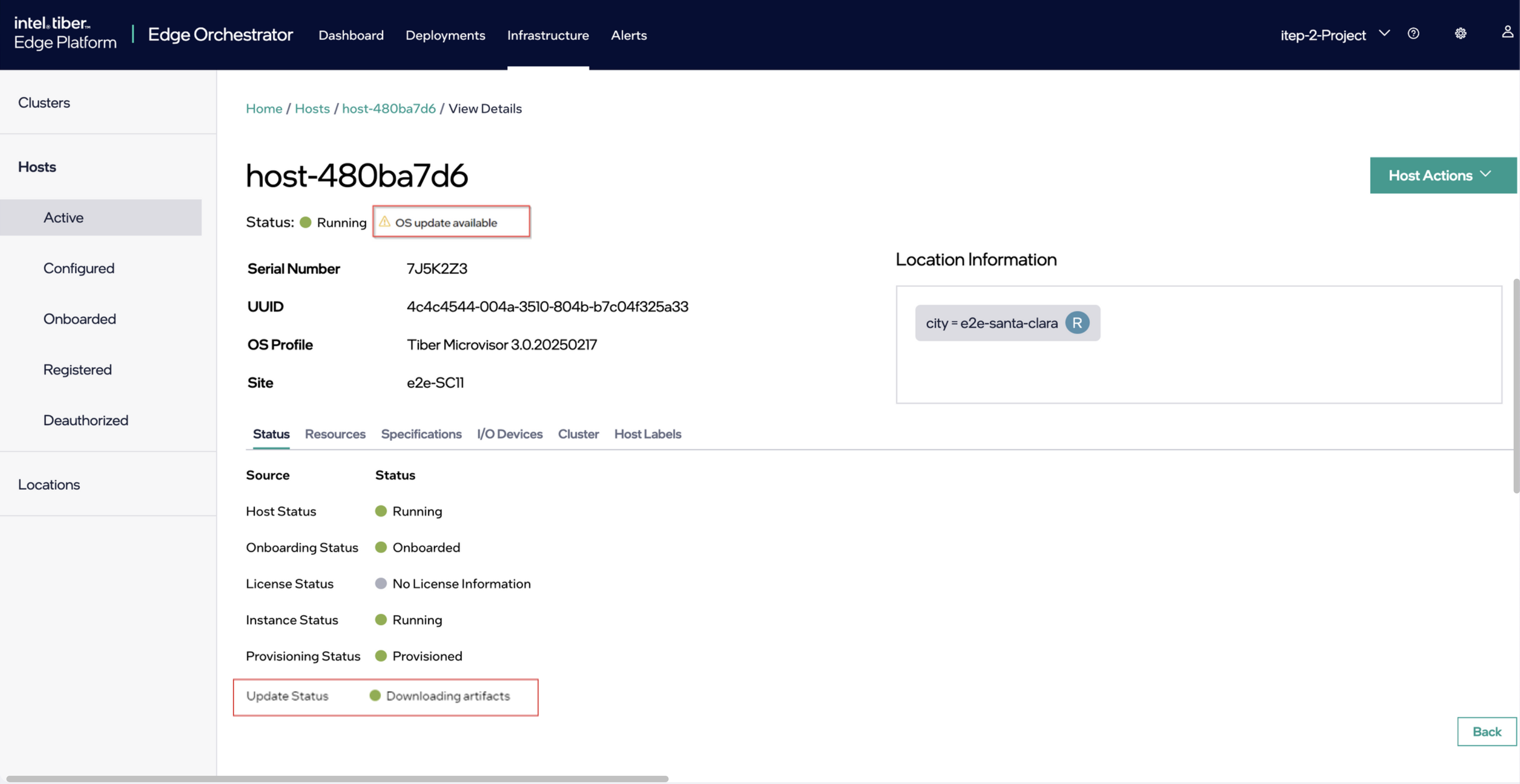
In case of completed or failed update additional update status details are recorded per instance:
UpdateType - indicates if it was an OS, application, configuration, or firmware update.
PackageName - contains package name in case of mutable OS.
UpdateTime - contains timestamp.
Action - indicates if it was an upgrade, or fresh installation.
Status - indicates if action was successful or failed.
Version - contains package version in case of mutable OS.
FailureReason - indicates type of failure in case of immutable OS.
FailureLog - contains failure description in case of immutable OS.
Currently update status detail are accessible only through REST API queries. To view status details follow the steps:
Prepare environment variables
Refer to the API documentation for an explanation on how to retrieve the API authorization token.
export API_TOKEN="TOKEN_VALUE"
export CLUSTER_FQDN="example-orchestrator.intel.com"
export API_ENDPOINT="https://api.${CLUSTER_FQDN}/v1"
export PROJECT="example-project"
In the host view of the web UI, identify the host name of your EN:
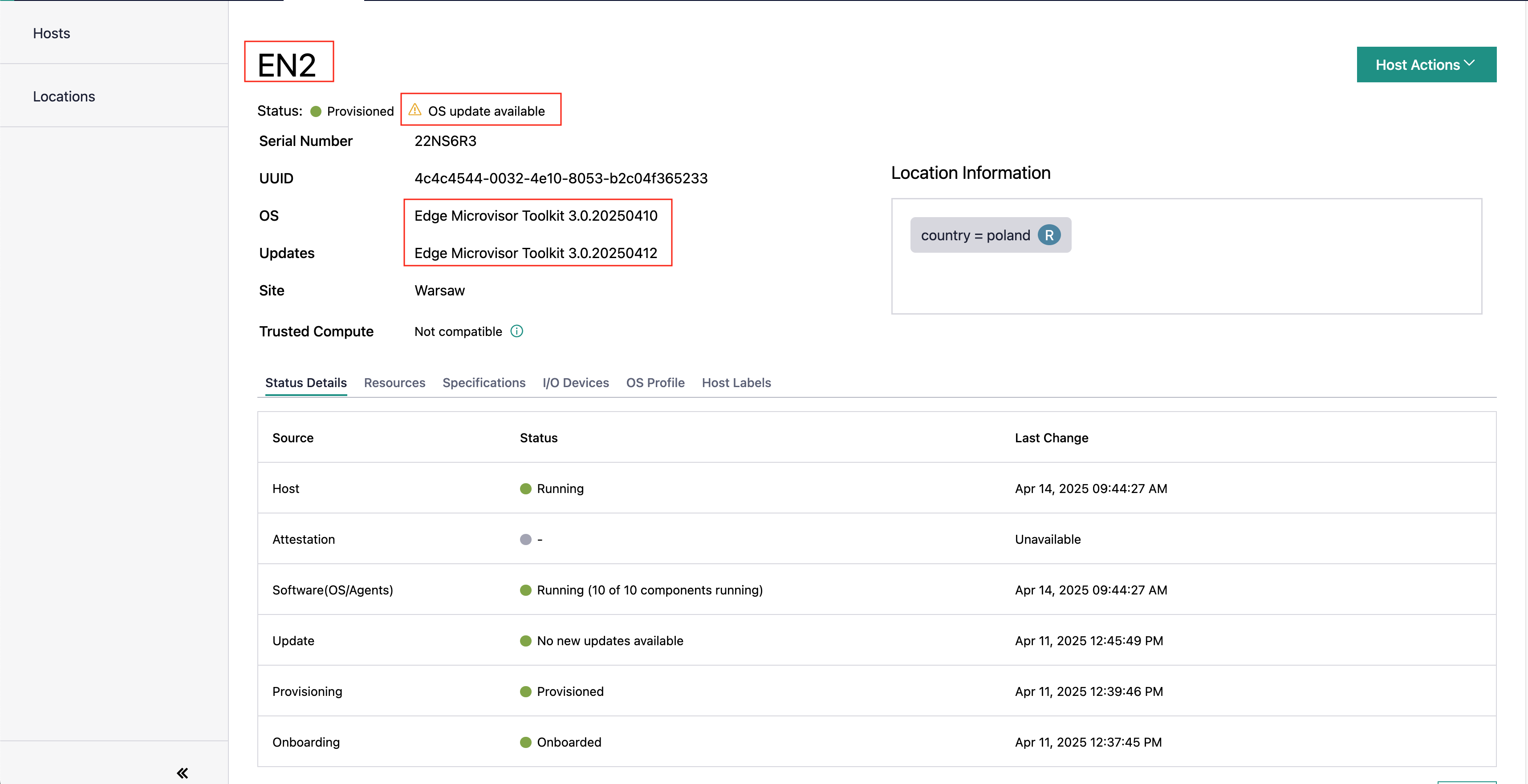
Add the host name to environment Variables
export HOST_NAME="example-host-name"
Query update status details through the instances API endpoint by filtering by the host name and update status detail.
curl -X GET "${API_ENDPOINT}/projects/${PROJECT}/compute/instances" -H "accept: application/json" -H "Authorization: Bearer ${API_TOKEN}" | jq '.instances[] | select(.host.name == "${HOST_NAME}") | .updateStatusDetail'